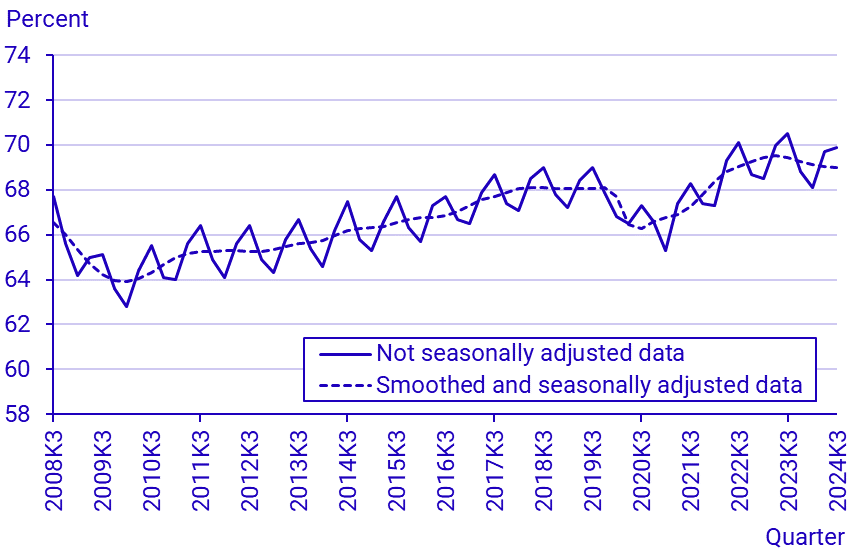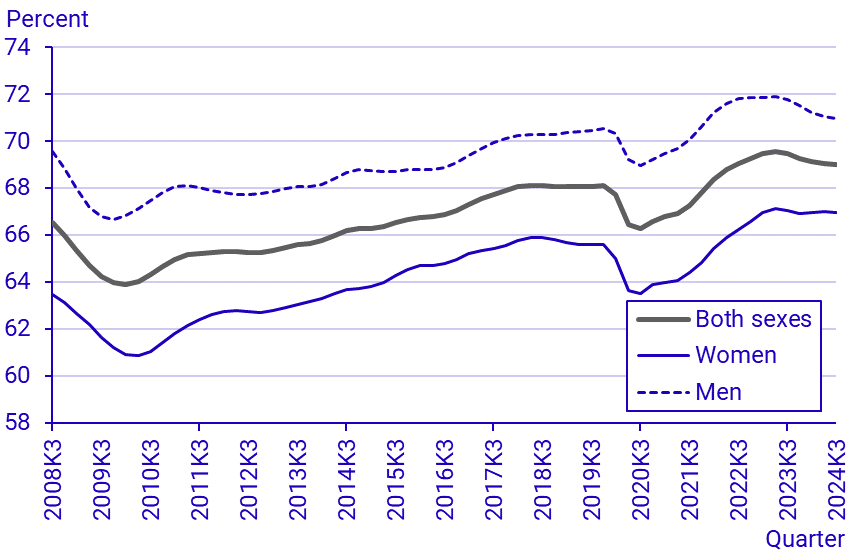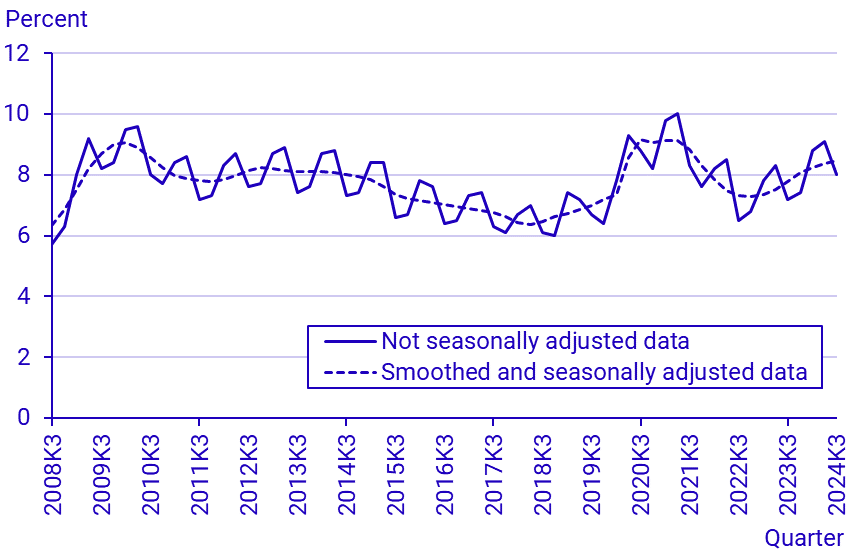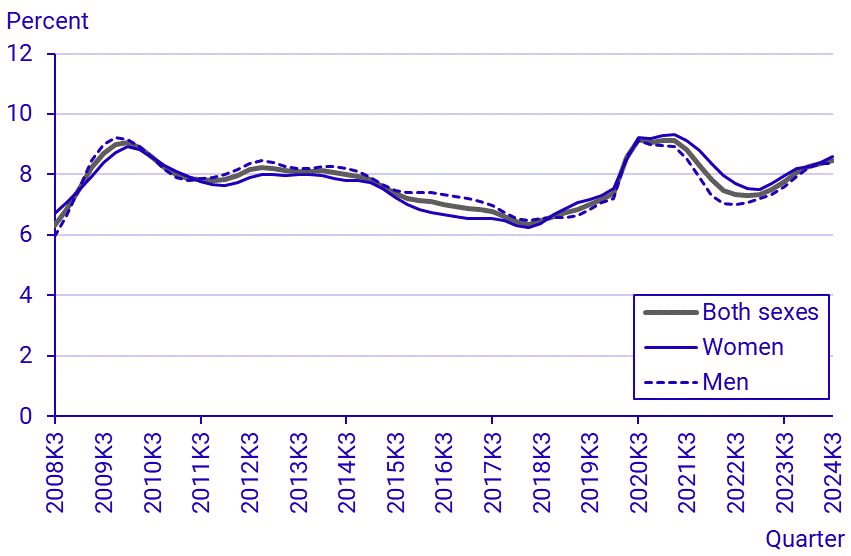Labour Force Survey (LFS), third quarter 2024
Unemployment increased during the third quarter
Statistical news from Statistics Sweden 2024-11-05 8.00
In the third quarter of 2024, the number of employed people amounted to 5 311 000, not seasonally adjusted. The average number of hours worked per week amounted to 137.4 million hours. In calendar adjusted figures, this corresponds to a decrease of 1.8 percent compared to the third quarter 2023. There were 459 000 unemployed people, which was an increase of 41 000 people. This corresponds to an unemployment rate of 8.0 percent, an increase of 0.8 percentage points. Seasonally adjusted and smoothed data show an increase in both the share and the number of unemployed. This corresponds to an unemployment rate of 8.5 percent.
Due to a higher recommended retirement age from 2023, the reporting of the subgroup 20–64 years has been changed to 20–65 years.
- Unemployment continued to rise during the third quarter 2024. Meanwhile, the number of temporary employees continued to decrease, primarly among women. Also, the number of hours worked decreased, says Elin Ottosson Bixo, statistician at the Labour Force Surveys at SCB.
The labour force
The number of people in the labour force aged 15-74 years amounted to 5 770 000 during the third quarter of 2024, not seasonally adjusted. The number of women in the labour force amounted to 2 765 000 and the number of men was 3 005 000. The relative labour force participation rate amounted to 75.9 percent. Among women, the labour force participation rate was 74.0 percent and among men it was 77.8 percent.
According to seasonally adjusted and smoothed data, the number of people in the labour force during the third quarter of 2024 amounted to 5 731 000, which corresponds to 75.4 percent of the population.
Employment
In the third quarter of 2024, the number of employed persons decreased by 40 000 and amounted to 5 311 000 people aged 15–74 years, not seasonally adjusted. This corresponds to an employment rate of 69.9 percent, a decrease of 0.6 percentage points compared to the corresponding quarter in 2023. Among women, the number of employed was 2 533 000 and among men the number of employed decreased by 46 000 and amounted to 2 778 000. The employment rate for women was 67.7 percent and among men it was 71.9 percent, a decrease of 1.2 percentage points. There were 563 000 young people aged 15–24 years in employment, a decrease of 29 000. This corresponds to an employment rate of 46.7 percent, a decrease of 3.0 percentage points.
For people aged 15–74 years, seasonally adjusted and smoothed data shows that the number of employed people during the third quarter of 2024 amounted to 5 245 000, which corresponds to an employment rate of 69.0 percent.
Employees
In the third quarter of 2024, there were 4 802 000 employees, not seasonally adjusted. The amount of employed women was 2 388 000 and the amount of employed men decreased by 37 000 to 2 414 000. The number of permanent employees amounted to 4 104 000. Among permanent employees, the number of women increased by 50 000 to 2 022 000 and the number of men was 2 081 000. There were 699 000 temporary employees, a decrease of 55 000. Among them 366 000 were women, a decrease of 37 000. The corresponding number for men was 333 000.
According to seasonally adjusted and smoothed, the number of employees amounted to 4 741 000. Among employees, 4 108 000 had a permanent employment and 633 000 a temporary employment.
Hours worked
The average number of hours worked per week in the third quarter of 2024 amounted to 137.4 million hours, not seasonally adjusted. In calendar adjusted figures, this corresponds to a decrease of 1.8 percent compared to the third quarter 2023. According to seasonally adjusted and smoothed data, the number of hours worked averaged to 154.7 million per week. This is a decrease compared to adjacent quarters.
Most employed people have an agreed working time of 35 hours or more per week, that is, full-time work. In the third quarter of 2024, 4 189 000 people worked full time. Among them 1 864 000 were women and the number of men decreased by 56 000 to 2 325 000. In total, 227 000 people worked short part-time (1–19 hours), and the number of people who worked long part time (20-34 hours) amounted to 634 000 people.
The average actual hours worked among employed people aged 15–74 years amounted to 25.9 hours per week in the third quarter of 2024. Women worked 23.9 hours per week and men 27.8 hours per week.
Underemployment
Among employed people aged 15–74 years, 349 000 were underemployed in the third quarter of 2024. The number of underemployed women amounted to 154 000 and the number of men was 194 000. Underemployed people accounted for 6.6 percent of employed people.
Unemployment
In the third quarter of 2024, there were 459 000 unemployed people aged 15–74 years, not seasonally adjusted. This was an increase of 41 000 people compared to the corresponding quarter previous year. The unemployment rate amounted to 8.0 percent, an increase of 0.8 percentage points. There were 232 000 unemployed women and the number of unemployed men increased by 27 000 to 227 000. The unemployment rate for women was 8.4 percent. The corresponding number for men was 7.6 percent, an increase by 1.0 percentage points.
For people aged 15–74 years, seasonally adjusted and smoothed data shows an increase in both the number and the share of unemployed people compared to adjacent quarters. The number of unemployed amounted to 486 000 in the third quarter of 2024, which corresponds to an unemployment rate of 8.5 percent.
There were 162 000 long-term unemployed people (unemployed for at least 27 weeks) aged 15–74 years in the third quarter of 2024, not seasonally adjusted. That is an increase of 33 000 compared to the corresponding quarter previous year. Among long-term unemployed people, the number of women was 81 000, an increase of 19 000, and the number of men amounted to 81 000.
The number of unemployed young people aged 15–24 years increased by 22 000 and amounted to 146 000, not seasonally adjusted. This corresponds to an unemployment rate of 20.6 percent, an increase by 3.3 percentage points. For people aged 15–24 years, seasonally adjusted and smoothed data shows an increase in both the number and share of unemployed people compared to adjacent quarters. The number of unemployed young people amounted to 168 000, corresponding to an unemployment rate of 24.6 percent.
Not in the labour force
The group 'not in the labour force' includes people who are not classified as employed nor as unemployed. In the third quarter of 2024, there were 1 832 000 people not in the labour force. The number of women not in the labour force was 974 000 and the number of men was 858 000.
Among people not in the labour force, 820 000 were retired, which is a decrease of 29 000, 347 000 were full-time students and 314 000 people reported that they were on long-term sick leave.
Latent job seekers
There were 276 000 latent job seekers aged 15–74 years in the third quarter of 2024. Among them, 136 000 were women and 140 000 were men. Among young people aged 15–24 years, the number of latent job seekers was 149 000.
Unused labour supply
Unemployed people, underemployed people and latent job seekers together comprise the unused labour supply. In the third quarter of 2024, the unused labour supply averaged 24.3 million hours per week, an increase of 1.8 million hours compared to the corresponding quarter in 2023. The unused labour supply corresponds to 608 000 full-time employments with 40-hour work weeks.
Labour market for people aged 20-65 years
The population presented by the LFS is comprised of people aged 15–74 years. However, labour market participation among younger and older in this age group is considerably lower for natural reasons, as this group contains large shares of students and retired people. To better approach what can be seen as the core of the actively working population, the situation of the age group 20–65 years is described in the following section.
The relative labour force participation rate among people aged 20–65 years amounted to 87.9 percent in the third quarter of 2024, not seasonally adjusted. For women, the relative workforce participation rate was 86.2 percent, and for men the number decreased by 0.9 percentage points to 89.6 percent. Seasonally adjusted and smoothed data shows a participation rate of 87.5 percent, which is a decrease compared to adjacent quarters.
In the third quarter of 2024, the share of employed people aged 20–65 years was 81.9 percent, not seasonally adjusted. This was a decrease by 0.7 percentage points compared to the corresponding quarter previous year. For women, the share of employed people was 80.0 percent and for men it was 83.7 percent, a decrease by 1.4 percentage points. According to seasonally adjusted and smoothed data, the employment rate amounted to 81.2 percent, which corresponds to a decrease compared to adjacent quarters.
According to not seasonally adjusted data, the unemployment rate in the age group 20–65 years amounted to 6.9 percent. The unemployment rate among women was 7.2 percent and for men it was 6.7 percent. According to seasonally adjusted and smoothed data, the unemployment rate was 7.2 percent which is an increase compared to adjacent quarters.
Swedish born and foreign born people aged 20–65 years
The relative labour force participation rate among Swedish born people aged 20–65 years was 88.3 percent in the third quarter of 2024, not seasonally adjusted. Among Swedish born women the labour force participation rate was 87.2 percent, and among Swedish born men it was 89.4 percent. Among foreign born people aged 20–65 years, the relative labour force participation rate was 86.9 percent. The corresponding figure among foreign born women was 83.4 percent and 90.3 percent among foreign born men. According to seasonally adjusted and smoothed data, the labour force participation rate was 87.8 percent among Swedish born people and 86.5 percent among foreign born people. That is a decrease of labour force participation rate among Swedish born people compared to adjacent quarters.
In the third quarter of 2024, the share of employed Swedish born people aged 20–65 years was 84.7 percent, not seasonally adjusted. Among Swedish born women, the employment rate was 83.7 percent and among Swedish born men the employment rate was 85.6 percent. Among foreign born people, the employment rate decreased to 74.2 percent. Among foreign born women, the employment rate was 69.9 percent and among foreign born men it decreased by 2.4 percentage points to 78.5 percent. Seasonally adjusted and smoothed data shows that the employment rate was 84.1 percent among Swedish born people and 73.4 percent among foreign born people. This was a decrease among Swedish born people respectively an increase among foreign born people, compared to adjacent quarters.
The relative unemployment rate among Swedish born people aged 20–65 years was 4.1 percent in the third quarter of 2024, not seasonally adjusted. Among Swedish born women, the unemployment rate was 4.0 percent, and the male unemployment rate was 4.3 percent. The unemployment rate among foreign born people was 14.6 percent. Among foreign born women it was 16.3 percent and among foreign born men the corresponding number was 13.1 percent. Seasonally adjusted and smoothed data shows that the unemployment rate was 4.3 percent among Swedish born people and 15.2 percent among foreign born people. This was an increase among Swedish born people respectively a decrease for foreign born people, compared to adjacent quarters.




Source: Statistics Sweden
Definitions and explanations
Since the LFS is a sample survey, the results are subject to some uncertainty. The LFS basic tables contain uncertainty figures and refer to non-seasonally adjusted data.
Seasonally adjusted and smoothed data (trend values): data in which normal seasonal variations have been removed, then smoothed to reduce sampling error and short-term variations. Seasonally adjusted and smoothed data may be revised following new monthly outcomes and usually does not coincide with non-seasonally adjusted data. Seasonally adjusted and smoothed data is not to be compared with non-seasonally adjusted data.
More detailed results are available in the form of figures and tables on employed persons, hours worked, unemployed persons and more, on Statistics Sweden’s website.
Next publishing will be
2024-11-15
Feel free to use the facts from this statistical news but remember to state Source: Statistics Sweden.
